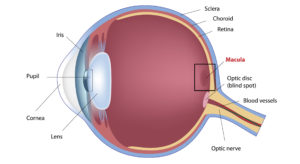In addition to February being Heart Disease Awareness Month, its also Age-Related Macular Degeneration (AMD) Awareness Month.
A very common condition, Age-Related Macular Degeneration (AMD) is the leading cause of vision loss in people age 50 and older. AMD is a disease of the eye that blurs the central, sharp vision needed for daily activities like reading, driving, and watching television. If you break down the name of the condition into its parts, “age-related” means it happens most often in older people, “macular” means it affects the macula of the eye, and “degeneration” means the deterioration and loss of function in cells of a tissue or organ.
Where is the “macula” of the eye?

AMD doesn’t cause complete blindness, rather it makes it difficult to do things that require close-up focus, like recognizing faces or cook. It happens rather slowly in some people. Even if you have early AMD, you may not lose your vision for a long time. For others, it progresses faster and can lead to vision loss in one or both eyes.
Symptoms of Age-Related Macular Degeneration
Blurry area near center of vision, which may get bigger over time, or you see blank spots. Some may notice straight lines that look wavy, this can be a warning sign of late onset AMD.
Risk Factors of Age-Related Macular Degeneration
Your risk of developing AMD increases as you get older. People 60+ are more likely to have it. Your risk also increases if:
You have a family history of AMD
You are Caucasian
You smoke
Please remember to get regular eye exams if you have any risk for developing AMD. Early AMD doesn’t have any symptoms, so don’t wait for your vision to blur!
How to lower your risk of developing AMD
Quit smoking, or don’t start
Exercise regularly
Maintain healthy blood pressure and cholesterol
Eat healthy foods- including leafy greens and fish
How does my doctor find if I have AMD?
A dilated eye exam! Your eye doctor will give you some eye drops to dilate, or widen, your pupil and check your eyes for AMD and other eye problems.
What’s the treatment?
Unfortunately, there is no treatment for AMD. Your eye doctor will keep track of how your eyes are doing via regular exams.
There are some dietary supplements that may be able to stop AMD from progressing.
For those with “wet” or neovascular AMD, there are some treatments that may help slow or even stop further vision loss. These treatments can include anti-VEGF drugs that are injected directly into the eye or photodynamic therapy (PDT) which is commonly referred to as laser therapy.
Always be sure to visit your eye doctor and primary care physician to get regular check ups! And if St. Anthony’s Hospice or Palliative care can benefit you, please call us at (270) 826-2326.
